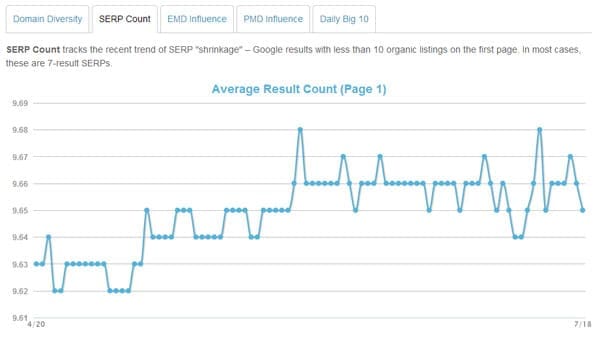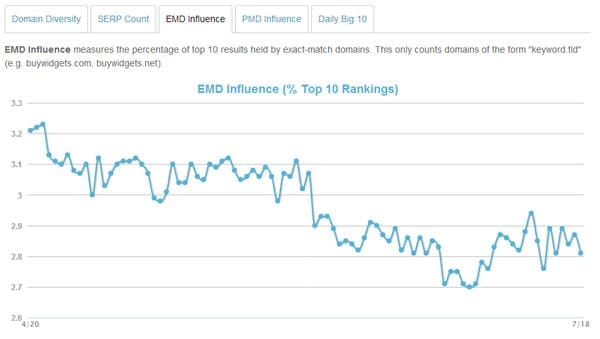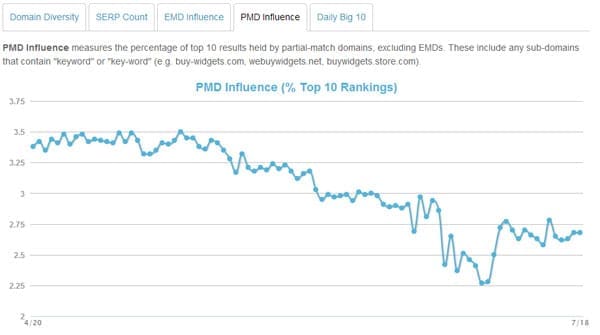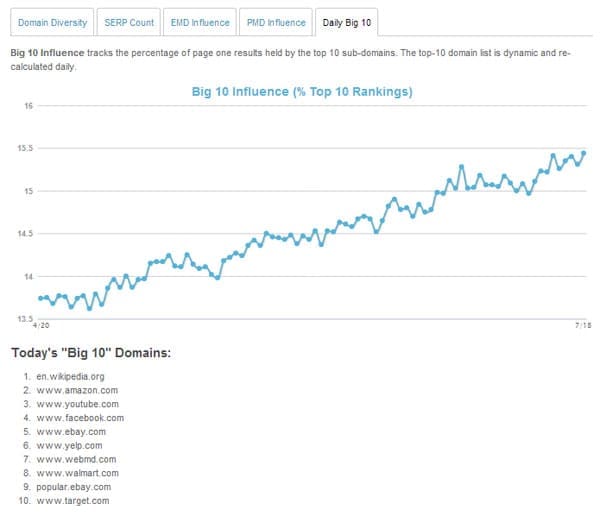We spend a lot of time here at Return On Now analyzing SEO Trends, with a heavy focus on the latest algorithm updates from Google and Bing. In performing this SEO Trend analysis, we use a variety of tools to do so.
One of the more interesting offerings is MOZcast. Provided by the team at moz.com (formerly seomoz.com), this service aims to measure disruption in the SERPs based on a weather analogy.
How MOZcast Helps Analyze SEO Trends
MOZcast is set up to provide a weather report for SERP volatility on a daily basis. When the SERPs are in some sort of significant upheaval, the weather will heat up and get more stormy. When it’s business as usual, it’s like a nice day in the Bay area – mild and sunny.
From the MOZcast home page, you can view today’s weather as well as the past 30 days. See below for the MOZcast from Wednesday July 17, 2013.
So Wednesday was fairly level, with a nice 62 degree, sunny day. Looking back over the past month, you can see that there was some serious movement going on during late June and early July. The peaks to the left were June 25, 27, and 28, while the four tall lines in the middle were July 1 – 4. We know that Google was slowly rolling out a fairly major update starting on June 25, so it correlates nicely.
You can read more about the data they use to drive this analysis on the MOZcast “About” page.
Other Metrics MOZcast Tracks
The daily weather report is the primary feature on the MOZcast site, but not the only information available there. They track five other key metrics back 30, 60, or 90 days. These metrics dig deeper into exactly what types of sites are being impacted when the weather gets cloudy or stormy. Let’s look at those five metrics now.
Domain Diversity
Domain diversity is meant to track how clogged up the SERPs are with same domain results. The metric shows what percentage of unique sub-domains (as opposed to TLDs) are represented across the universe of URLs included in the analysis. Essentially, the lower the Domain Diversity, the more clogged up the SERPs will be with the same domains across multiple search terms.
Here is their Domain Diversity trend chart for the past 90 days.
As you can see in this image, the SERPs have become more and more filled up by a smaller subset of subdomains. This is either good or bad. If it means that their anti-SPAM tactics are cleaning up all the junky sites, then you could consider it a good SEO trend. If it means that brands are starting to own an inordinate amount of SERP real estate over the smaller players, this could easily be construed as bad.
I like to see more domain diversity, but do understand the tradeoffs between spammy sites and high quality content providers. If nothing more, this SEO trend toward less domain diversity is something to monitor as Panda and Penguin continue to grow in impact.
SERP Count
Since Local SEO became a huge deal, we have seen SERPs that sometimes display fewer than 10 organic results on the first page. In response to this SEO trend, MOZcase provides data to show the average result count in the SERPs across their data set. Take a look at the last 90 days of data below.
Last year, we saw this number trending downward. Now, we see it heading north again. Any idea why? I’d wager that the introduction of the carousel for local results in mid-June factored heavily into this trend. I’ve seen a ton of commentary on the carousel, some of it negative. If this is truly a boon to the quantity of organic results now showing on page 1 again, perhaps the alleged drop in traffic from local SEO listings won’t sting as badly. We shall see in the coming months.
EMD Influence
Back in September of 2012, Google rolled out what they referred to as their EMD Update. EMD is short for “Exact Match Domain”, meaning domains that were exact matches for money keywords. The net result of the EMD Update was a significant falloff in organic traffic for EMDs.
MOZcast was smart to include this in their service. Below is the chart analyzing what percent of the top 10 organic rankings went to EMDs over the past 90 days.
As you can see, EMDs not only represent a very small percentage of the overall page one organic SERP real estate, but they are still in a downfall as Google keeps rolling out newer tweaks to the algorithm. They appear to have hit a low point around the time of the latest algorithm rollout, after which they rebounded slightly. Still, at less than 3% of all page one SERP listings, EMDs are on their last legs. If you aim to launch a new website, avoid keyword rich EMDs.
PMD Influence
Recent updates have begun to more heavily impact not only EMDs, but PMDs (Partial Match Domains) as well. PMDs are domains that are not an exact match for a money keyword, but that are nearly that. Take a look at the chart for PMDs below.
It is pretty clear that PMDs have been under attack over the past two months, most noticeably in the past few weeks since June 25. This PMD situation has come with some collateral damage, where reputable sites were hit in addition to spammers. Fortunately, the initial hit was temporary, and PMDs bounced back part of the way to where they sat before this dropoff kicked in during June.
Just to be safe, you might want to avoid launching any new sites on PMDs. We don’t know if this is a one time deal or Google will come after them more aggressively in the future.
Daily Big 10
The Daily Big 10 focuses on what share of the top 10 rankings are commanded by the 10 subdomains which appear most frequently among the data set analyzed. The members of the top 10 change by day, but you will see the same names appearing on this list most of the time. Take a look at the trend line and list of yesterday’s Big 10 below.
The biggest concern in reviewing this trend line is that it is going up. Why? Because it has been trending upward for quite some time now. The latter part of it appears to be at least somewhat inversely correlated to the EMD and PMD trends, so that can explain some of it. But Google has gone on record saying that they prefer brands in their latest algorithm tweaks. This is a trend that I expect to continue, and only Google knows when it will level out for good (if ever).
Conclusion
MOZcast is a great service, and we use it a lot to analyze unexpected changes on behalf of websites we manage. It often diagnoses that Google is making a change before Google even admits it publicly. If you see something odd and unexpected happening with your website traffic and overall organic performance, give a look to MOZcast to figure out if it’s across the web or unique to your own website. It is a great tool for eliminating possible causes when diagnosing surprises with website performance.
Tommy Landry
Latest posts by Tommy Landry (see all)
- AI Traffic Is Changing the Funnel, and Marketers Need to Catch Up - July 1, 2025
- How to Optimize for Retrieval-Augmented Generation (RAG) - June 24, 2025
- From Overwhelm to Action: Building AI Skills Inside Your Marketing Team - June 17, 2025











